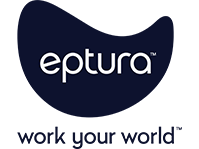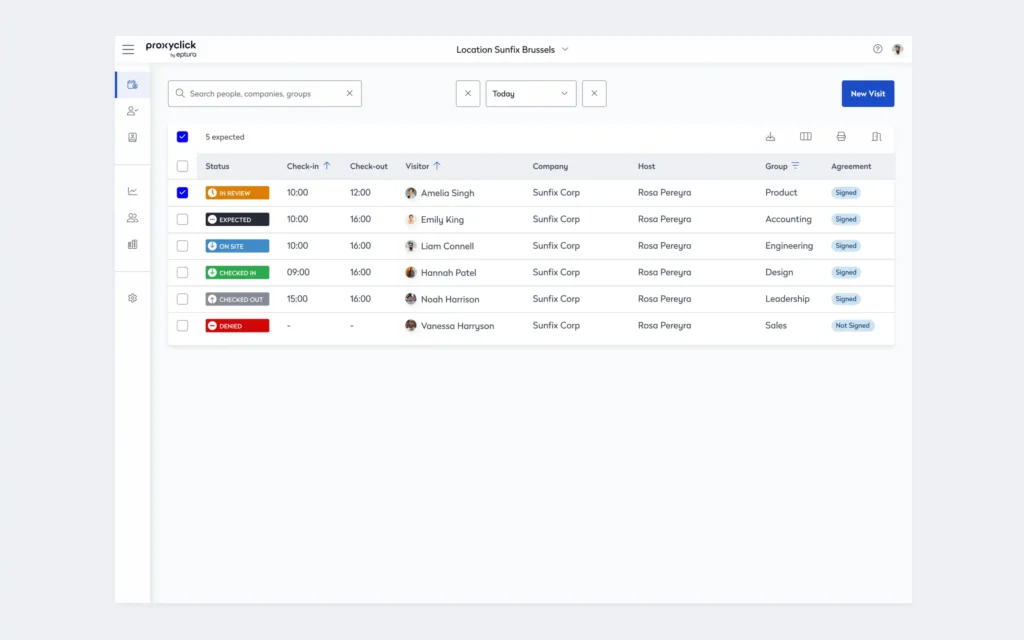
As a facility manager, you face a series of challenges that test your skills, patience, and resourcefulness every day. You’re in charge of everything from managing unexpected equipment failures to ensuring the safety, comfort, and productivity of everyone in your facility. Your responsibilities are extensive, and the stakes are high.
By embracing digital transformation and implementing an integrated worktech platform, you can improve every part of your day.
What does the average day look like for facility managers?
Depending on how far along your organization is on its digital journey, it can vary from slow, frustration-filled work to smooth-sailing productivity.
By looking at an average day, you can see the various challenges facility managers face and the real-world results from our customers.
How to coordinate the commute
You’re not even all the way into the parking lot before your phone is buzzing with email alerts. You quickly park and check your phone only to see every subject line is some variation of “parking issue – someone took my spot!”
With the introduction of the hybrid work model, organizations like yours have had to find new ways to manage all their spaces, from single desks to boardrooms — even parking spaces. With fewer employees coming into the office every day of the workweek, the old system of long-term assigned spots makes less sense, but without something to replace it, you now worry that employees can run into roadblocks before they even step into the office.
Business intelligence leader Dun & Bradstreet sees reduction in parking challenges
As part of a larger project to improve facility management, Dun & Bradstreet, a global leader in business data and analytics, saw a reduction in parking challenges at their European offices once employees could book spots before arriving. The system helps employees solve the immediate challenge of finding a place to park at work. But it also helps the company with resource allocation because it now has reliable data on desk occupancy and parking reservations to leverage for long-term planning.
Read the full story to discover how this company with 6,000 employees and 25 locations worldwide quickly scaled to a system that manages 2,880 spaces across multiple facilities.
How to make a good first impression and set visitors up for success
You step into the lobby, straight into the long, slow line to get past reception and into the building.
It’s the start of the day, and you’re already in the thick of what can go wrong in a traditional lobby with a person sitting at the front desk. Manual check-ins are time consuming, leading to long wait times and congestion, especially during busy periods when people are more likely to be impatient, pressed for time to get to their desks and meetings. The delays not only frustrate visitors but also overwhelm the receptionist, who must juggle multiple tasks like answering phones and managing deliveries.
And on top of wasting time, you’re also compromising security. It’s difficult to track and verify every visitor’s identity and purpose, increasing the risk of unauthorized access. And when you’re asking people to log into a manual book, you’re also inviting them to look at all the names of the people who checked in before them, revealing sensitive information.
KFC and Pizza Hut Singapore enhance the visitor experience with faster check-ins
KFC and Pizza Hut, two of the world’s most recognized fast-food brands, operate a shared office building in Singapore that serves as a hub for their corporate operations. Both host a diverse range of visitors, from suppliers and partners to job applicants and customers.
After struggling with time- and labor-intensive manual methods, they decided to implement an advanced automated visitor management system. The goal was to streamline the check-in process, reduce wait times, and enhance the overall visitor experience. With digital check-in at kiosks via Eptura Visitor, visitors can now quickly and securely register their details, reducing the administrative burden on reception staff.
The automated check-in process has significantly reduced wait times, with an average reduction of 75%, improving the visitor experience and increasing the efficiency of the reception area, allowing staff to focus on other important tasks. Compliance with data privacy regulations has also been a major success, with the company reporting a 100% compliance rate.
Get the complete story on how Pizza Hut and KFC manage visitors.
Dimension Data streamlines, strengthens visitor NDAs
Dimension Data, a leading global technology solutions provider, welcomes up to 500 visitors per month at each of its multiple locations across the European Union. They’d relied on paper-based logbooks for visitor check-ins, but on top of the long wait times, the company struggled to manage visitors’ confidentiality agreements (NDAs).
The company installed digital kiosks, reducing check-in times by up to 50%, improving the visitor experience, and reducing the burden on reception staff. And the system supports the signing of NDAs and other confidentiality agreements, ensuring that sensitive information is handled securely. Real-time visitor tracking and automated access control further enhance security, while the digital platform ensures GDPR compliance by securely managing and storing visitor data.
“The trust we offer to our people when they share their information with us. We ensure total security thanks to Eptura,” explains Pierre Dumont, Managing Director.
Read Dimension Data’s story to learn how visitor management helps with confidentiality compliance.
How to manage your real-estate portfolio and match spaces to employee needs
From the lobby, you grab the elevator to the third floor. The doors open and you’re met with rows of empty single desks, while all the boardrooms are packed with employees, some having to stand because there aren’t enough chairs. Somehow, you have both too much and not enough space, and it’s costing you in overhead and lost productivity.
Too much unused space means you’re wasting money on rent, utilities, and maintenance. If a company is paying for a 10,000 square foot office but only using 7,000 square feet, the cost of maintaining the extra 3,000 square feet can quickly add up, diverting funds that could be better allocated to other business needs. And it’s not just the amount of space. It’s also the types.
Having the wrong types of spaces in an office affects productivity and well-being. For example, when employees are forced to conduct team meetings and brainstorming sessions in noisy, open workspaces or makeshift areas, there are too many distractions, diminishing the quality of collaboration and decision-making.
For enterprise-level organizations, each additional location increases the challenge exponentially. With more moving parts — including country- and region-based differences in office norms, best practices, and compliance requirements — it’s harder to effectively, efficiently manage spaces.
Sodexo cut real estate by 50% while enhancing employee experience
Sodexo is a leading provider of integrated facilities management and food services, but they faced several challenges at their flagship office in Central London. The office had many single desks but lacked sufficient boardrooms and meeting areas, leading to disruptions in team meetings and brainstorming sessions. And the company was spending a lot to maintain a large office space with low utilization.
By implementing Eptura’s workspace booking solution, which includes advanced software for managing and booking meetings and personal spaces, they are able to optimize the use of available office space and improve the overall work experience. Because the software provides real-time visibility of available spaces, employees can easily book boardrooms, meeting rooms, and personal desks as needed, not only streamlining the booking process but also ensuring that they use office space more efficiently, reducing the need for additional or external facilities.
A significant benefit for the company was a reduction in real estate costs. Sodexo was able to reduce its office space by 50%, saving £2.5M ($3.1M) over five years.
Discover additional benefits Sodexo saw by implementing desk booking.
UK accountancy aligns spaces with employee needs
A leading United Kingdom accountancy firm faced a common challenge: How best to better accommodate their workforce and prepare for future expansions? They needed to improve space efficiency and enhance the workplace experience to better support evolving employee needs and preferences.
By implementing Eptura’s data-driven solutions, they were able to first capture and then leverage comprehensive data on office usage and resource utilization to right-size their office spaces effectively. By taking control of their data, they were able to tailor workspace arrangements independently by uploading and modifying their own floor plans without the need for additional fees.
The solution empowered the firm to manage over 35,000 bookings annually, utilizing data-driven insights to streamline workspace management, optimize workspace allocation, and even improve parking management.
See how a UK accounting firm created consistency across multiple locations.
How to move the team from reactive to proactive maintenance
You get to your office and start to review your notes from the day before. There’s a lot to go over, and you’ll need to follow up with people across many different departments. The phone rings and the IT department reports that the AC is down in the main server room where your company houses its business-critical applications.
Running a maintenance department with a reactive strategy, especially one that relies heavily on manual methods, means you’re never able to get ahead. Frequent last-minute repairs and unplanned downtime disrupt operations and increase costs. Technicians spend too much time logging maintenance activities by hand, which is not only time-consuming but also prone to errors. And the lack of real-time visibility into asset status makes it difficult to identify and address potential issues before they become critical, leading to higher failure rates and extended downtime. Inefficiencies strain resources, reduce productivity, and impact overall operational reliability and safety.
It’s as true for facility managers running office buildings as it is for those in other industries, including energy, education, government, healthcare, and manufacturing.
Maritime Developments goes digital and saves more than eight hours a week per technician
Maritime Developments (MDL), a leading company in the maritime and subsea operations sector, faced significant challenges in its subsea operations, primarily related to the inefficiency and unpredictability of maintenance processes. The company’s reliance on reactive maintenance led to frequent last-minute repairs and unplanned downtime, which not only increased costs but also posed risks to operational safety and reliability. Technicians spent too much time logging maintenance activities manually, which was both time-consuming and prone to errors. Additionally, the lack of real-time visibility into the status and performance of critical assets made it difficult to identify and address potential issues before they escalated into major problems.
MDL implemented a digital asset management platform that provides real-time visibility into the status and performance of its subsea assets. The primary goal was to shift from reactive to predictive and preventive maintenance to reduce the need for last-minute repairs and minimize parts replacement. They can now monitor asset health continuously, enabling technicians to identify and address potential issues proactively. And by automating maintenance logging, the platform has also saved technicians over eight hours a week, allowing them to focus on more critical tasks and improving operational efficiency.
By moving to proactive maintenance, they have seen a 15% decrease in overall maintenance costs and a 20% reduction in unplanned maintenance, allowing them to invest in other areas, including employee training and technology upgrades, further enhancing its operational capabilities.
Read the complete customer story to learn exactly what asset data MDL is able to leverage in its asset maintenance program.
Proven success in facility and maintenance management
As a facility manager, you know firsthand the complexity and pressure that come with your role. From juggling maintenance teams to ensuring the safety and satisfaction of everyone in your building, the challenges are constant. Our success stories highlight how with the right tools and strategies, you can not only meet these challenges but excel in them. Modern digital solutions have transformed every aspect of daily operations, helping you deliver efficient, reliable, and safe facilities.







